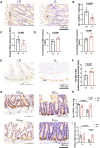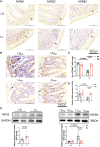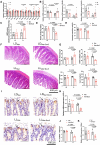Long-term exposure to constant light disrupts intestinal stem cells through sympathoexcitation-induced Wnt5a signaling inhibition
- PMID: 40438259
- PMCID: PMC12116419
- DOI: 10.1093/gastro/goaf031
Long-term exposure to constant light disrupts intestinal stem cells through sympathoexcitation-induced Wnt5a signaling inhibition
Abstract
Background: Long-term exposure to constant light is becoming a prevalent lifestyle that is associated with irritable bowel syndrome (IBS), a chronic functional gastrointestinal disorder. Intestinal stem cells (ISCs) are an important population of cells that maintain homeostasis and function of intestinal tissues. The purpose of this study was to identify the effects of long-term constant light exposure on gastrointestinal function and the potential mechanisms of sympathetic activity on ISC.
Methods: Rats housed in a 24 h constant light chamber for 4 weeks were used as the constant light exposure animal model. Hematoxylin-eosin staining and immunohistochemical examination were used to determine the pathological changes of the intestine. Propranolol (ARs inhibitor; 40 mg/kg/day), metoprolol (ADRβ1 inhibitor; 50 mg/kg/day), and Box5 (Wnt5a inhibitor; 2 μg/day) were used to examine the effect of sympathoexcitation and Wnt signaling pathway on constant light-induced gastrointestinal disorders.
Results: We found that 4 weeks of constant light exposure in rats resulted in a decrease in the number of ISC and an increase in sympathetic activity. Intestinal β1-adrenoceptor expression and reactive oxygen species (ROS) were significantly increased, but Wnt5a expression decreased in the continuous light-exposed rats. Similarly, we found that administration of the β1-adrenoceptor antagonist metoprolol for 4 weeks attenuated the effects of continuous light exposure on the intestine, which was rescued by the reintroduction of Wnt5a.
Conclusion: Taken together, these data indicate that sympathoexcitation is critical for disruption of ISC under constant light exposure, suggesting that targeting β1-adrenoceptor/oxidative stress/Wnt5a axis may be a potential strategy for ISC disruption induced by prolonged sustained light exposure, providing a new direction for IBS treatment.
Keywords: IBS; ROS; Wnt5a; constant light; intestinal stem cells; sympathoexcitation.
© The Author(s) 2025. Published by Oxford University Press and Sixth Affiliated Hospital of Sun Yat-sen University.
Conflict of interest statement
All the authors report no relevant conflicts of interest for this article.
Figures






Similar articles
-
Sertindole for schizophrenia.Cochrane Database Syst Rev. 2005 Jul 20;2005(3):CD001715. doi: 10.1002/14651858.CD001715.pub2. Cochrane Database Syst Rev. 2005. PMID: 16034864 Free PMC article.
-
Etanercept and efalizumab for the treatment of psoriasis: a systematic review.Health Technol Assess. 2006 Nov;10(46):1-233, i-iv. doi: 10.3310/hta10460. Health Technol Assess. 2006. PMID: 17083854
-
Corticosteroids for the treatment of Duchenne muscular dystrophy.Cochrane Database Syst Rev. 2016 May 5;2016(5):CD003725. doi: 10.1002/14651858.CD003725.pub4. Cochrane Database Syst Rev. 2016. PMID: 27149418 Free PMC article.
-
Levetiracetam add-on for drug-resistant focal epilepsy: an updated Cochrane Review.Cochrane Database Syst Rev. 2012 Sep 12;2012(9):CD001901. doi: 10.1002/14651858.CD001901.pub2. Cochrane Database Syst Rev. 2012. PMID: 22972056 Free PMC article.
-
Interventions for infantile haemangiomas of the skin.Cochrane Database Syst Rev. 2018 Apr 18;4(4):CD006545. doi: 10.1002/14651858.CD006545.pub3. Cochrane Database Syst Rev. 2018. PMID: 29667726 Free PMC article.
References
-
- Sperber AD. Epidemiology and burden of irritable bowel syndrome: an international perspective. Gastroenterol Clin North Am 2021;50:489–503. - PubMed
-
- Ng SC, Shi HY, Hamidi N et al. Worldwide incidence and prevalence of inflammatory bowel disease in the 21st century: a systematic review of population-based studies. Lancet 2017;390:2769–78. - PubMed
LinkOut - more resources
Full Text Sources

